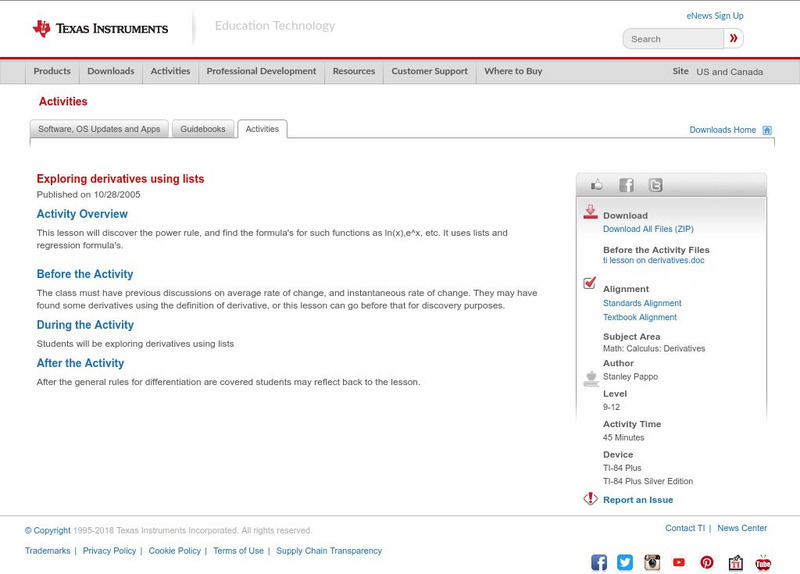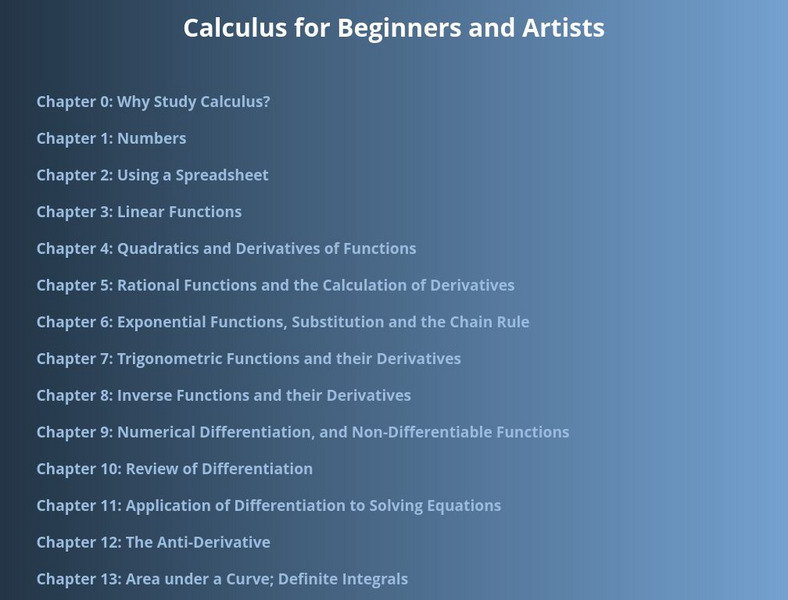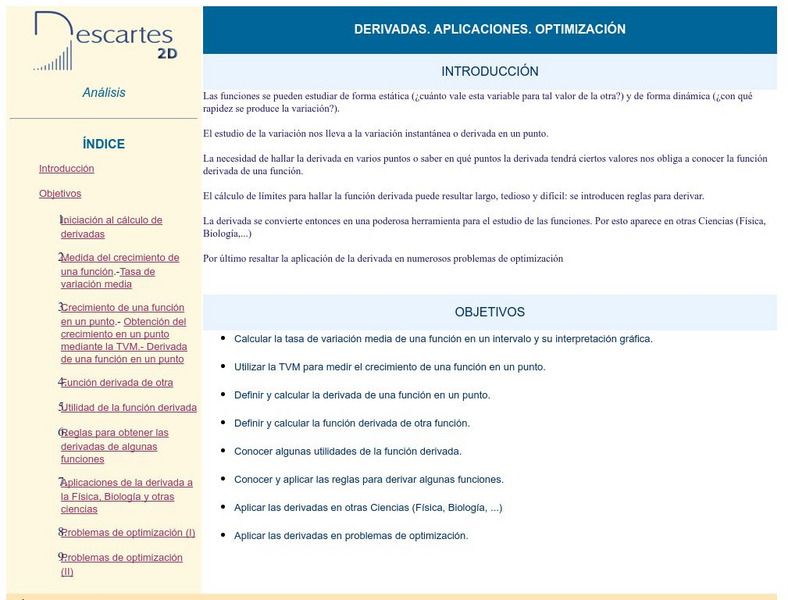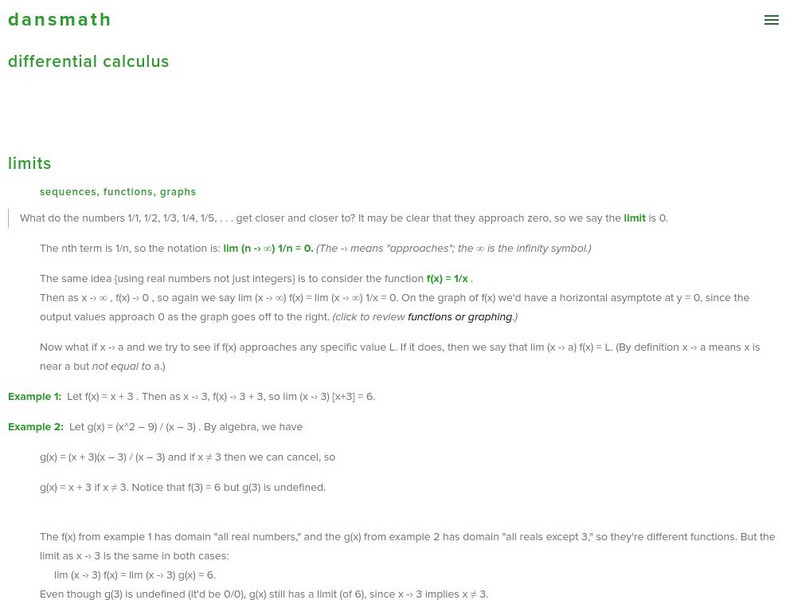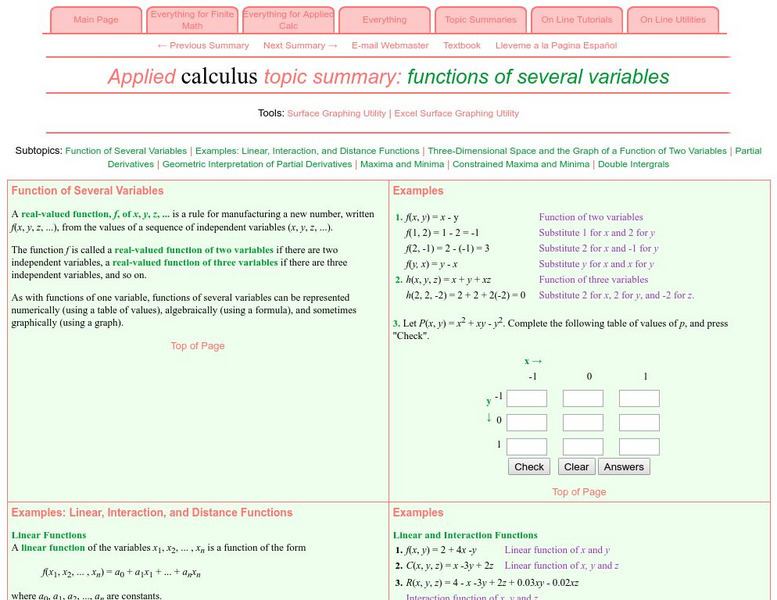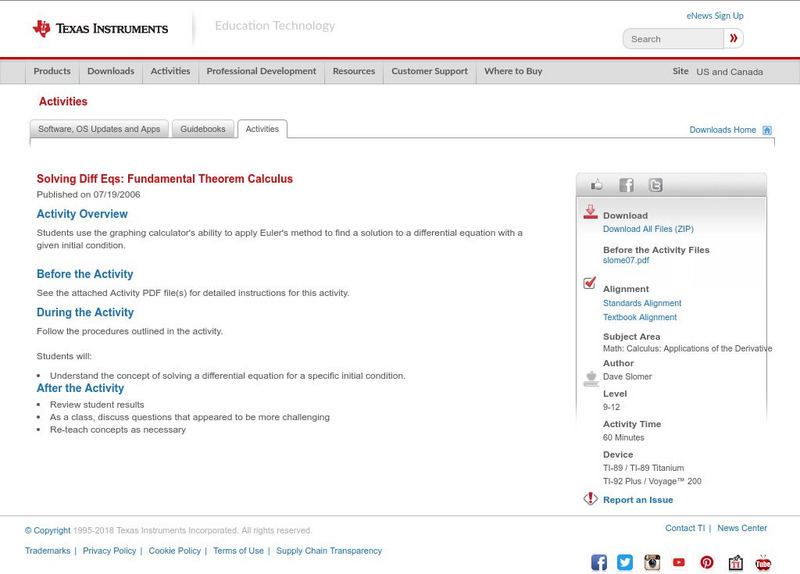Lawrence Hall of Science
The Math Page: An Approach to Calculus: Applications of Maximum and Minimum Values
Here is a site that clearly and thoroughly explains how to solve applied max/min problems using the first derivative. There are example problems solved, problems for the student to attempt, and answers to the student problems. Point this...
Texas Instruments
Texas Instruments: Planting & Harvesting an Application of the Definite
In this Derive activity, students apply the concept of definite integration and decide when a farmer should plant and harvest a crop of clover.
Texas Instruments
Texas Instruments: Exploring Derivatives Using Lists
This lesson will discover the power rule, and find the formulas for such functions as ln(x),e^x, etc. It uses lists and regression formulas.
Massachusetts Institute of Technology
Mit: Calculus for Beginners and Artists
Students learn about Calculus concepts through online notes, applets, and dialogs. Topics include derivatives, integrals, linear functions, and derivative applications.
Ministry of Education and Universities of the Region of Murcia (Spain)
Ministerio De Educacion Y Ciencia: Derivadas. Aplicaciones. Optimizacion.
In Spanish. This interactive unit is intended to show you how to calculate the derivative of a function and the application of the derivative in other sciences.
Texas Instruments
Texas Instruments: Graphing Relationships
In this activity, students explore information about a graph based on the first and second derivatives. They learn that a function's derivative is positive when the function increases and negative when the function decreases. They learn...
Texas Instruments
Texas Instruments: General Quadratics, Cubics, and Quartics
This activity explores the characteristics of the graphs of quadratic, cubic, and quartic functions. The graphing calculator will be used to generate graphs and derivatives of these functions.
Texas Instruments
Texas Instruments: Hairpin Curves
This activity uses derivatives to determine whether a vehicle of a certain length can traverse sharp curves on a trip up a mountain.
Texas Instruments
Texas Instruments: Optimization
This activity illustrates how the derivative is used to find a solution to an optimization problem.
Other
Dans Math: Lessons: Calculus (Part 1)
College professor Dan Bach reviews the basic calculus concepts of limits and derivatives. The site includes examples and animated graphs.
Stefan Warner and Steven R. Costenoble
Finite Mathematics & Applied Calculus: Topic Summaries: Functions of Several Variables
The topic summary outlines functions of several variables. Some topics reviewed are partial derivatives, double integrals, real-valued function, and three-dimensional space. The resource consists of definitions, notes, and examples.
Texas Instruments
Texas Instruments: Hot Coffee
This activity is an application of differential equations and slope fields. Students first go through the traditional paper and pencil method of solving a differential equation. (Continued. See "before the activity.")
Texas Instruments
Texas Instruments: Zeros of a Cubic
This activity involves some of the prerequisites of calculus relating to functions and equations. It also contains an application of differentiation. (Continued. See "before the activity.")
Texas Instruments
Texas Instruments: Hot Tub
This activity is an application of integration. Students first use the calculator to determine specific numeric results to enable them to understand the dynamics of the problem. (Continued. See "before the activity.")
Texas Instruments
Texas Instruments: Features of the Ti 89 That Maximize Its Use
This Computer Algebra System (CAS) activity encourages students to investigate the various functions and applications of the CAS calculator. They study and practice various types of problems in algebra and calculus with the help of the...
Texas Instruments
Texas Instruments: Jet Plane
This activity is an application of differentiation involving related rates. Students set up equations relating the variables and then differentiate them with respect to time to find the rate a distance is changing and an angle is changing.
Other
Science Direct: New Lower Bounds for the Three Dimensional Finite Bin Packing
This article analyzes the three-dimensional finite bin packing problem (3BP). The 3BP finds many practical applications as it is a simplified version of many real-world problems, e.g. container and pallet loading.
Texas Instruments
Texas Instruments: Using Slope Fields
In this activity, students identify whether a slope field approximately reflects a differential equation. They also determine whether a potential solution fits the slope field.
Texas Instruments
Texas Instruments: Confectionery Delight
Students first make physical models using paper and scissors to get a grasp of the problem and to determine how to set it up. They then use the CAS of the TI-89 and calculus to determine the dimensions of the box which gives the maximum...
Texas Instruments
Texas Instruments: Solving Diff Eqs: Fundamental Theorem Calculus
This activity exclusively uses the graphing calculator's ability to apply Euler's method to find a solution to a differential equation with a given initial condition.
Other
Taro: An Application of the Derivative
This is a somewhat lengthy site discussing applications of the derivative using a trajectory problem as a template for understanding the concept. The page begins by defining a quadratic equation given three distinct points and then...
Interactive Mathematics
Interactive Mathematics: Instantaneous Rate of Change
The derivative is applied to real world applications of velocity in an example using "h" notation and limits.
Interactive Mathematics
Interactive Mathematics: More on Curve Sketching
Examples are presented to demonstrate the steps for sketching curves that are not polynomials. Using x- and y-intercepts, limits, domain and range, maxima and minima, second derivatives and general behavior the graphs are constructed...
Interactive Mathematics
Interactive Mathematics: Tangents and Normals
Finding the slopes and equations of the tangent and normal lines of curves is demonstrated using derivatives. Interactive examples are provided.


